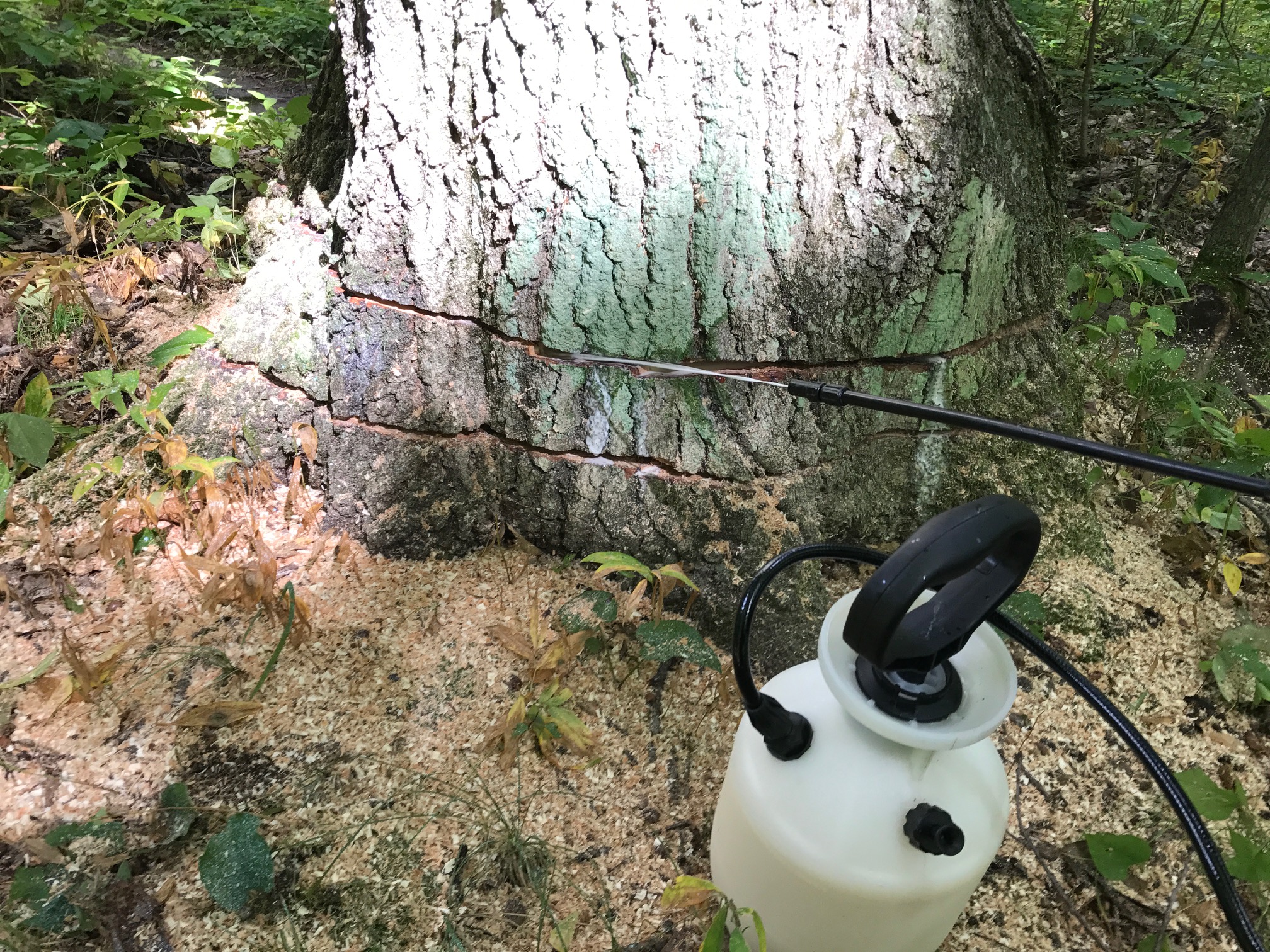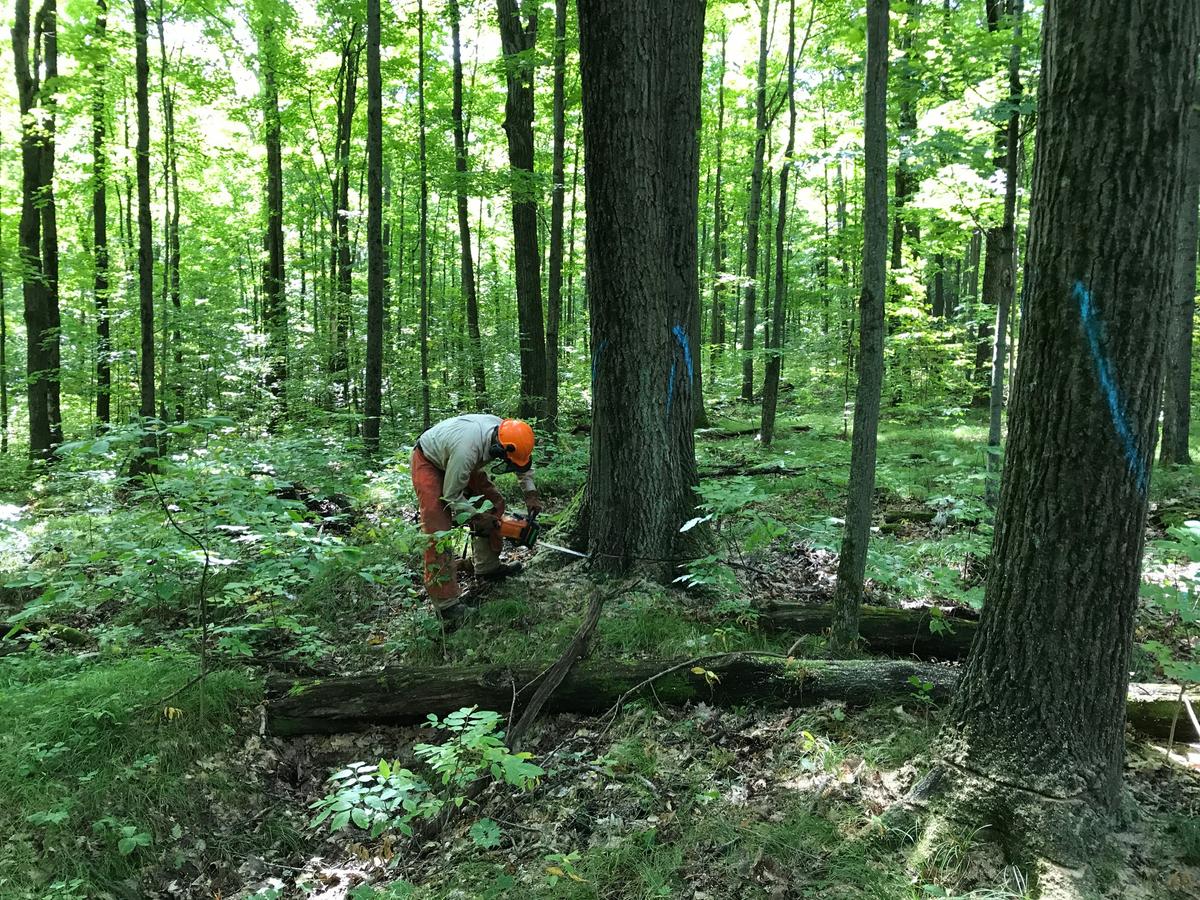Overview
Oak wilt first appeared in two sites on the property in 2002. Vibratory plows are not feasible on the site, so an herbicide field trial was initiated in 2003. In these trials, infected trees and healthy trees a certain distance from the infected are treated with an herbicide. Sites continue to be monitored, and new treatment areas have been identified as new oak wilt infestations are identified. As of August 2017, 17 sites are under treatment.
Silviculture Objective(s)
Stop the spread of an active oak wilt pocket in order to maintain oaks into the future
Pre-treatment stand description and condition
Pre-treatment species composition:
Northern Red Oak is the dominant species in the over-story. Stand has high densities of Red Maple saplings in the understory. Witch-hazel is also a major component of the understory.
Pre-treatment growth and stocking:
As of 2001, Stand 251 had an average basal area of 76 sq. ft. per acre. Average tree height of over-story was 74 feet tall and Mean Stand Diameter was 12 inches.
Pre-treatment forest health issues:
Two oak wilt sites were found in 2002, and were treated in 2003.
Landowner objectives/situation:
An herbicide field trial was initiated in 2003 at 2 sites on the Nine Mile Forest. Between the two sites, 11 trees were treated, using Johann Bruhn's model to identify potentially root grafted neighbor oaks. In 2004, a third site was established due to miscalculations for inclusion trees at site 1. All treated trees were harvested in fall of the year they were treated. The stand has continued to be monitored, and new oak wilt sites identified and treated in a similar fashion. In total, as of 2017, 17 sites have been identified and treated with the girdle herbicide technique, encompassing over 300 trees.
Johann Bruhn's model is described in detail in Bruhn, J.N., and Heyd, R.L., 1992. Biology and Control of Oak WIlt in MIchigan Red Oak Stands. Northern Journal of Applied Forestry 9(2): 47-51. See also "Oak Wilt Management - What are the options?" in Supplemental Documents below.
Silviculture Prescription
An herbicide field trial was initiated in the Nine Mile Recreation Area on the Marathon County Forest in 2003 after two oak wilt sites were found in late summer 2002 . Because use of a vibratory plow was not an option for this site, we used a girdle technique to kill northern red oak trees that were infected with oak wilt and / or within root grafting distance of infected stems as identified using Johan Bruhn’s model.
Oak regeneration harvest shall be implemented in 2019 by conducting a Two-Cut Shelterwood. Herbicide treatment of understory Witch-hazel and Red Maple saplings, to be conducted prior to harvest. Scarification to establish seedbed for oak seedlings shall also be conducted prior to harvest.
What actually happened during the treatment
The prescription specified that all trees marked for treatment were treated with Garlon 4. Prior to herbicide application, each treatment tree was to be frill girdled in two circles with a chainsaw. The girdles were to be placed minimum 6” apart, and the highest girdle was no more than 18” from the ground. The cuts circled around the stem edge to edge horizontally and were at least 1 inch in depth to ensure exposing the xylem. Garlon 4 solution was applied to the frill girdles and on the bark down for thorough coverage. Seedlings (< 1” diameter) were not to be treated, to encourage oak regeneration.
When a treated tree has not shown wilting symptoms within several weeks, a second girdle treatment is done lower on the trunk. This has not occured very often.

Figure 1: Close-up of girdle treatment
Post-treatment assessment
All treated trees are harvested in the fall of the year of treatment. There has been no value loss on the logs.
In regards to the success of the treatement on killing oak trees, in 2 of the 17 sites thus far, a tree or two did not wilt within 2 weeks. In those cases, treatment was repeated, but girdled lower with great results.
The method has been effective, with no expansion of oak pockets after treatment.
No artificial efforts have been made to ensure oak regeneration. Several sites have witch hazel and red maple regeneration, while a couple have adequate natural white oak regeneration.
Costs and economic considerations
The diesel and herbicide costs total $2.07 per tree. Labor has not been a consideration in the costs.
Other notes
This is one of many sites treated under a 5-year oak wilt containment study. That case study is also on the Silviculture Library and is titled "5 Year Oak Wilt Containment Study (WI DNR)".
Summary / lessons learned / additional thoughts
The managers believe their oak wilt protocol works, and will continue to follow it. They have varied their treatment to occur in fall, rather than mid-July and report the same results.
This case study was developed with support from the United States Department of Agriculture's National Institute for Food and Agriculture (USDA-NIFA), Renewable Resources Extension Act (RREA). Project #MIN-44-E02, principal investigator Eli Sagor, University of Minnesota.
